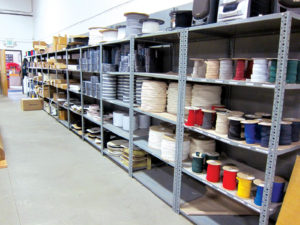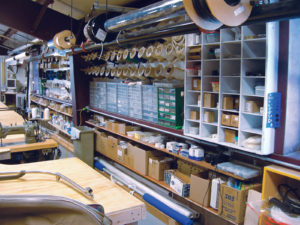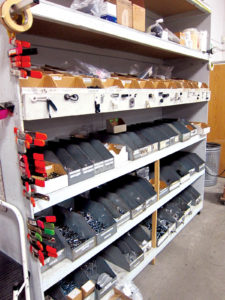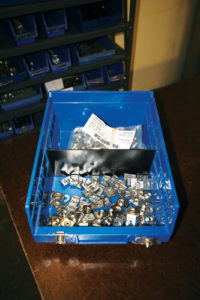Inventory management
Marine fabricators have one thing in common: a desire to maximize their shop layouts and rack space to optimize profits, inventory and shop efficiencies. For many fabricators, breaking away from the “buying bulk” philosophy means streamlining production processes. For others, having plenty of stock on hand may mean higher degrees of product selection for their customers. This balancing act of supply versus demand is an age-old tenet that works in different ways for different fabricators.
Inventory know-how

For some fabricators, the “just in time” philosophy streamlines production. For others, buying in bulk provides more product selection for their customers.
For Jeff Viehmeyer, owner of Alameda Canvas &Coverings in Alameda, Calif., being located near the distribution centers for some of the largest suppliers allows him to obtain needed materials and supplies on short notice, even same day for many items.
“We can keep on-hand inventories relatively lean,” Viehmeyer says. “We plan a material run each week or so based on the shop schedule for major projects, and pick up general shop stock as needed on those runs.”
The key for Jay Hanks, owner of Allerton Harbor Canvas, Hull, Mass., is to keep an inventory of the commonly used items and for all employees to monitor inventory of labeled bins and clear drawers after using the item.
“They write on a supply order sheet when the quantity falls low,” Hanks explains. “Some items have their own order sheet and orders are batched together to save on shipping. It is important that you align vendors that have overnight shipping or may have a weekly van delivery. Most of our fabric is ordered by cut yardage and normally is delivered the next day.”
Some critical items do require longer lead times, so the Alameda team keeps sufficient stock of those items to cover normal small-project needs for longer periods.
“We have noticed an increasing tendency for suppliers to be out of stock on important items, or not to have all parts of an assembly available at one time, so we adjust our shop stock upwards accordingly,” Viehmeyer says.
“We stock ‘wide and shallow’—a little bit of everything, especially hard-to-get items, so we can get going on almost any project immediately if needed, obtaining the additional material while commencing work. This also allows us to have samples of many items on-hand for customers to see and touch, so they can decide and formalize the project plans.”
Tom Matson at Afton Marina & Yacht Club in Afton, Minn., generally stocks the items that they use on a regular basis: clear vinyl sheets, zippers, fasteners, webbing, hook-and-loop and thread.
“Most of these items are generally stocked in black or white, so they will work on most jobs,” Matson says. “We order the fabric for each project on a per-job basis.”
Seasonality and region play a big role in inventory methodology for many marine fabricators. “We work on smaller boats, and our season is really short so we are a volume-type business, doing as many as we can in as short an amount of time as we can,” says Mike Charpentier at Paul’s Custom Canvas in Denver, Colo. “We keep just about everything that we use daily in stock. This includes materials because we try to turn most jobs within a week. If a boat comes in and the customer wants a certain color, we want to have that color in stock so we can get their boat done within the week.”
Inventory tracking tools

Allerton Harbor Canvas diligently organizes its shop for quick access to inventory and to streamline efficiencies throughout its fabricating processes.
When it comes to embracing inventory technology tools, Viehmeyer finds that the time required to set up items, establish appropriate stocking levels (which vary by season), enter substitutions if available, and track usage is greater than the benefit received.
“We would have to be running a big warehouse or distribution center for the payoff in time to be worth it,” Viehmeyer says. “A simple mininum/maximum system for most items, posted on the storage container, works just fine for small shops.”
Hanks agrees. “We don’t track most of the items due to the fact that there are so many low-price items and the process of inventory would be a drain of our product time,” Hanks says. “We do track our larger tool and fixed assets through QuickBooks, as well as all purchases.”
Being part of a large marina, Afton Marina & Canvas has access to a marina management software program called DockMaster, which allows them to create purchase orders, receive inventory, and enter the inventory into each work order.
“We do not utilize PDAs or tablets,” Matson says. “I do use an iPad for customer estimates and sales presentations and I also have one of our supplier’s catalogs on the iPad.”
Ed Skrzynski, owner of Marco Canvas in Marco Island, Fla., says that for software it is garbage in and garbage out. “If someone takes an item out but fails to record it, the software is none the wiser and you soon find your nice inventory software is not accurate,” Skrzynski says. “Software-managed inventory is only accurate if you tell it what is truly happening and the only way that works is by hiring a full-time stock room manager to log items in and out. But that is just adding costs that smaller fabricators cannot handle.”
So Skrzynski and his team use KANBAN, an unattended system that is so simple everyone will use it and it saves them time and money. “KANBAN means ‘card signal’ in Japanese,” Skrzynski says. They set up an inventory rack and locking cabinets and use blue parts bins with plastic bin dividers in the middle. The front of the bin has a picture or taped sample item on the front to make the item easier to locate.
“The front bin has what is called ‘active inventory’ and that is what the fabricators use as needed,” Skrzynski says. “Once that supply is consumed there is a ‘reserve inventory’ behind the active inventory. That reserve inventory is still just a small amount that is in a box or bag that has a laminated KANBAN card on it. When the reserve is needed, the fabricators must remove the card to get to the inventory. The card is placed in a dedicated box and the reserve inventory is moved to the active inventory. At the end of the day, we pull the cards and reorder the supplies. Our cards have all the information needed to reorder so we don’t waste time trying to identify what it is and whom we should buy it from. Information on the card includes supplier name, part number, grade, how much to order, our retail price (in case we get someone off the street wanting to by the item), and the stock location, such as cabinet letter, shelf number and position.”
The cards also have the supplier’s part number in bar code so they can go right to their website and scan the part number to further reduce human entry error. They then use the card as receivable confirmation. When the items are shipped, they match the cards to the items to ensure they received the correct item and amount and then place the card back on the box or bag.

Paul’s Custom Canvas Inc. in Denver has developed a systematic way of keeping its inventory organized and housed so that it is easily accessible and can be quickly inventoried during the shop’s short, yet busy season.
“Using the stock location ID on the card tells us exactly where that item needs to go and so it gets put back in the ‘reserve’ bin and the cycle repeats,” Skrzynski says. “So we always have a small amount of each item, about enough for one or two jobs, and never run out and shut down a job, never over spend on buying too much, reduce our time and costs to reorder supplies, and we do not need a dedicated person to manage inventory. We do not track our inventory per se, but we do know what we use and we know that we actually spend less as the 11 staff no longer hoard inventory as they know we will always have what they need to get the job done.”
Denver-based Paul’s Custom Canvas uses the old-fashioned paper and pencil method of monitoring its inventory. “Because of our short season, we just can’t spend the time taking an ongoing inventory,” Charpentier says. “We definitely keep track of what we are using, but we also use Microsoft Excel to know what we’ve purchased in previous years and what we will need for our season.”
Purchasing parameters
The purchasing activities of shops—both large and small—play an important role on their inventory management and storage solutions. One of the key factors in purchasing decisions lies in the effect inventory levels have on cash flow.
“Inventory cost can be a significant drain on cash flow, especially if expensive items are unused for extended periods or get damaged,” Viehmeyer says. “We pay for the materials needed for large projects from the 50-percent deposit we receive up front when taking on new projects.”

The front of the bin is Marco Canvas “active inventory” and the back of the bin has reserve inventory with a KANBAN card wrapped around it. Once the active items are used, the card is pulled, the reserve items are moved to the active bin and the card is sent to purchasing.
Skrzynski says buying in bulk means sitting on your cash for a long time and he simply doesn’t condone such methods. “I tend to like just-in-time deliveries of what is needed,” he says. “That said, as shipping costs go up due to fuel costs, we have made arrangements to change from smaller daily orders to larger weekly orders and have negotiated shipping costs to place one order a week versus daily for many items. This helps both us and our suppliers reduce costs.”
Overhead costs are fixed and are not typically a variable cost like inventory and labor, and as such, do not weigh much on purchasing decisions for Marco Canvas. “However, if we know that sourcing a particular item will consume administration labor time, then we add a small amount into the job to cover sourcing costs,” Skrzynski says. “Other than that, I urge companies to learn and separate fixed from variable costs and once you do you can then understand what your burden rate is. Your burden rate then should help determine a shop rate so that you are covering overhead costs, variable costs and desired gross profit margin versus just your variable costs.”
What’s in storage
Inventory management goes hand-in-hand with the practice of storing supplies and materials.
“Shop rental is expensive in our area,” Viehmeyer says. “We work to have shop layout be as efficient as possible, utilizing every square foot in a flexible manner.” At Alameda Canvas, material rolls are labeled for the job and stored in upright drums, as are windows. Shop perimeter walls are all lined with pegboard for in-process tools and small supplies or storage shelves for larger supplies and tools, utilizing the cube as high as possible to the ceiling.
“This frees the shop interior for working space,” Viehmeyer says. “Work tables and sewing machines are all on wheels, the same height, so they can be reconfigured or separated as needed according to the workflow in house.”
Hanks keeps his supplies organized and reminds his team to participate in watching for low levels. “Anticipate what you will need and order in time for the start of the project,” he says.
Where you store inventory can make a big impact on your productivity. That’s why Skrzynski has dedicated different parts of his shop to produce different items. “For example, for enclosures, covers and upholstery, core materials for each are mostly different,” Skrzynski says. “So items that are used for each department are stocked near that department. Items that are shared by both are in a centrally located stocking position. This keeps the supplies close to where they are used and reduces labor, time, fabricator’s frustrations and your costs.”
Skrzynski says employee buy-in to inventory management is critical. If they fail to use the systems then items can be found without stock.
“If you don’t have buy-in from your entire team, you could be fighting a losing battle,” Skrzynski says. “It is best to get them involved up front. Show them the problem and then, as a team, come to a solution.”
Maura Keller is a freelance writer and editor based in Plymouth, Minn.
 TEXTILES.ORG
TEXTILES.ORG 






